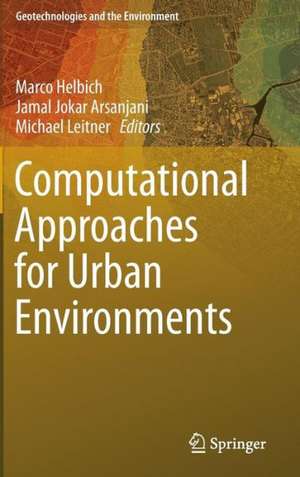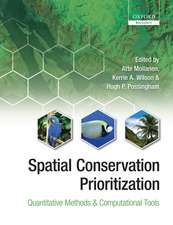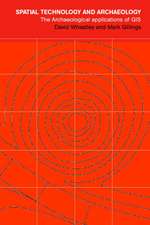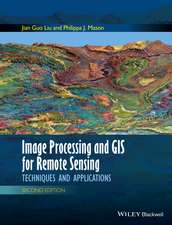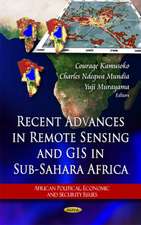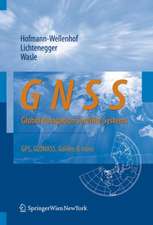Computational Approaches for Urban Environments: Geotechnologies and the Environment, cartea 13
Editat de Marco Helbich, Jamal Jokar Arsanjani, Michael Leitneren Limba Engleză Hardback – 5 feb 2015
Din seria Geotechnologies and the Environment
- 15%
 Preț: 649.71 lei
Preț: 649.71 lei - 18%
 Preț: 1408.89 lei
Preț: 1408.89 lei - 18%
 Preț: 1007.49 lei
Preț: 1007.49 lei - 18%
 Preț: 945.79 lei
Preț: 945.79 lei - 20%
 Preț: 566.50 lei
Preț: 566.50 lei - 18%
 Preț: 952.09 lei
Preț: 952.09 lei - 18%
 Preț: 948.92 lei
Preț: 948.92 lei - 15%
 Preț: 652.31 lei
Preț: 652.31 lei - 18%
 Preț: 951.77 lei
Preț: 951.77 lei - 15%
 Preț: 639.25 lei
Preț: 639.25 lei - 24%
 Preț: 746.98 lei
Preț: 746.98 lei - 24%
 Preț: 778.70 lei
Preț: 778.70 lei - 18%
 Preț: 952.72 lei
Preț: 952.72 lei - 18%
 Preț: 968.34 lei
Preț: 968.34 lei - 24%
 Preț: 790.70 lei
Preț: 790.70 lei - 18%
 Preț: 995.63 lei
Preț: 995.63 lei - 18%
 Preț: 886.92 lei
Preț: 886.92 lei - 5%
 Preț: 1106.69 lei
Preț: 1106.69 lei - 18%
 Preț: 1215.04 lei
Preț: 1215.04 lei - 15%
 Preț: 636.12 lei
Preț: 636.12 lei - 18%
 Preț: 967.08 lei
Preț: 967.08 lei - 15%
 Preț: 530.42 lei
Preț: 530.42 lei
Preț: 652.17 lei
Preț vechi: 767.26 lei
-15% Nou
Puncte Express: 978
Preț estimativ în valută:
124.79€ • 130.64$ • 103.26£
124.79€ • 130.64$ • 103.26£
Carte tipărită la comandă
Livrare economică 05-19 aprilie
Preluare comenzi: 021 569.72.76
Specificații
ISBN-13: 9783319114682
ISBN-10: 3319114689
Pagini: 340
Ilustrații: X, 395 p. 136 illus., 78 illus. in color.
Dimensiuni: 155 x 235 x 22 mm
Greutate: 0.74 kg
Ediția:2015
Editura: Springer International Publishing
Colecția Springer
Seria Geotechnologies and the Environment
Locul publicării:Cham, Switzerland
ISBN-10: 3319114689
Pagini: 340
Ilustrații: X, 395 p. 136 illus., 78 illus. in color.
Dimensiuni: 155 x 235 x 22 mm
Greutate: 0.74 kg
Ediția:2015
Editura: Springer International Publishing
Colecția Springer
Seria Geotechnologies and the Environment
Locul publicării:Cham, Switzerland
Public țintă
ResearchCuprins
Computational Approaches for Urban Environments: An Editorial.- Part I Spatial Planning and Decision-Making.- From Fractal Urban Pattern Analysis to Fractal Urban Planning Concepts.- Knowledge Discovery in Spatial Planning Data: A Concept for Cluster Understanding.- Clustering Contextual Neural Gas: A New Approach for Spatial Planning and Analysis Tasks.- Part II Housing and Real Estate.- Hedonic House Price Modeling Based on Multilevel Structured Additive Regression.- Simple Agents, Complex Emergent City: Agent-Based Modeling of Intraurban Migration.- Quantifying Urban Diversity: Multiple Spatial Measures of Physical, Social and Economic Characteristics.- Part III Urban Transportation and Mobility.- Everyday Cycling in Urban Environments: Understanding Behaviors and Constraints in Space-Time.- Performance Improvements for Large-Scale Traffic Simulation in MATSim.- Part IV Remote Sensing.- Recent Advances on 2D and 3D Change Detection in Urban Environments from Remote Sensing Data.-Fusion of Airborne Hyperspectral and LiDAR Remote Sensing Data to Study the Thermal Characteristics of Urban Environments.- Modeling Urban Land Use Change: Integrating Remote Sensing with Socioeconomic Data.- Part V Urban Sensing, Social Networks and Social Media.- Linked Activity Spaces: Embedding Social Networks in Urban Space.- Using Non-authoritative Sources During Emergencies in Urban Areas.- Towards a Comparative Science of Cities: Using Mobile Traffic Records in New York, London and Hong Kong.- Epilogue.
Recenzii
“In line with the theme of the book, these novel computation-intensive approaches … will doubtlessly inspire future researchers and bring urban environment research to the next level. … This volume will be of interest to broad groups of readers. … this collection of chapters should be a mandatory reading for those working on urban studies who would like to explore an increasing urbanization through fast updating technologies.” (Xiaohui Liu, The AAG Review of Books, Vol. 4 (3), July, 2016)
Notă biografică
Marco Helbich received his master and doctoral degrees at the Department of Geography and Regional Research, University of Vienna, Austria. He is currently an Assistant Professor at the Department of Human Geography and Spatial Planning, Utrecht University, The Netherlands and previously a recipient of an Alexander von Humboldt Fellowship. His research interests are in cities, computational modeling, spatial analysis, real estate, crime mapping and health geography. He has published 30+ refereed articles in top international journals in his discipline, such as Urban Geography, International Journal of Geographical Information Science, Annals of the Association of American Geographers, International Journal of Health Geographics, Journal of Transport Geography and others.
Jamal Jokar Arsanjani received his doctoral degree in Geographic Information Science (GISc) from the Department of Geography and Regional Research, University of Vienna, Austria. He is currentlyan Alexander von Humboldt Fellow at the Institute of Geography, Heidelberg University, Germany. His interdisciplinary research interests are in volunteered geographic information and crowdsourcing, geocomputation and spatial planning, remote sensing of the environment, and disaster management. He has published articles in leading international journals of his discipline, including International Journal of Applied Earth Observation and Geoinformation, International Journal of Digital Earth, Transactions in GIS, Cities and single-authored a book on Dynamic Land Use/Cover Change Simulation: Geosimulation and Agent-based Modelling with Springer publication.
Michael Leitner received a master degree at the Department of Geography and Regional Research, University of Vienna, Austria and a second master and a doctoral degree in GISc at the Department of Geography, State University of New York at Buffalo, US. He is currently a Professor of Geography in the Department of Geography and Anthropology, Louisiana State University, US and a faculty member in the Doctoral College “GIScience” at the University of Salzburg, Austria. He has previously received a Fulbright Scholarship and is the recipient of the 2007 Meredith F. Burrill Award from the Association of American Geographers. His research interests are in GISc and its application to spatial crime analysis, medical geography, and geospatial privacy. He has published two co-authored books, one single-edited book and 40+ refereed articles and book chapters. He is the current editor of Cartography and Geographic Information Science (CaGIS).
Jamal Jokar Arsanjani received his doctoral degree in Geographic Information Science (GISc) from the Department of Geography and Regional Research, University of Vienna, Austria. He is currentlyan Alexander von Humboldt Fellow at the Institute of Geography, Heidelberg University, Germany. His interdisciplinary research interests are in volunteered geographic information and crowdsourcing, geocomputation and spatial planning, remote sensing of the environment, and disaster management. He has published articles in leading international journals of his discipline, including International Journal of Applied Earth Observation and Geoinformation, International Journal of Digital Earth, Transactions in GIS, Cities and single-authored a book on Dynamic Land Use/Cover Change Simulation: Geosimulation and Agent-based Modelling with Springer publication.
Michael Leitner received a master degree at the Department of Geography and Regional Research, University of Vienna, Austria and a second master and a doctoral degree in GISc at the Department of Geography, State University of New York at Buffalo, US. He is currently a Professor of Geography in the Department of Geography and Anthropology, Louisiana State University, US and a faculty member in the Doctoral College “GIScience” at the University of Salzburg, Austria. He has previously received a Fulbright Scholarship and is the recipient of the 2007 Meredith F. Burrill Award from the Association of American Geographers. His research interests are in GISc and its application to spatial crime analysis, medical geography, and geospatial privacy. He has published two co-authored books, one single-edited book and 40+ refereed articles and book chapters. He is the current editor of Cartography and Geographic Information Science (CaGIS).
Textul de pe ultima copertă
This book aims to promote the synergistic usage of advanced computational methodologies in close relationship to geospatial information across cities of different scales. A rich collection of chapters subsumes current research frontiers originating from disciplines such as geography, urban planning, computer science, statistics, geographic information science, and remote sensing. The topics covered in the book are of interest to researchers, postgraduates, practitioners, and professionals. The editors hope that the scientific outcome of this book will stimulate future urban-related international and interdisciplinary research, bringing us closer to the vision of a “new science of cities.”
Caracteristici
Presents current and innovative technological developments reflecting urban environments Includes cutting-edge methods and data (e.g., cell-phone data) for urban analyses Will stimulate international research networks and enrich geographical science
